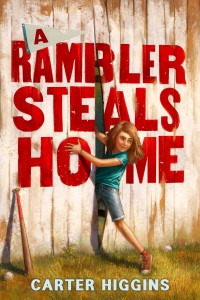Dear Editor…
From a practical (logistical) standpoint, do you have any advice for how to tackle a large revision of a manuscript I haven’t read in over a year? I’ve just had it professionally edited. I’m thinking I’ll read through those edits, then print out the manuscript and read the whole thing. And make changes as I go? Or read it through once and then go through again and make changes? Or read it electronically and then make changes and then print it out? I just can’t decide quite how to approach it.
Sincerely,
J.
 Carter Higgins has traveled a storyteller’s career path, from librarian to motion graphics designer and back to librarian. She is also the author of the middle grade novel A Rambler Steals Home (HMH, 2017) and the picture book Everything You Need for a Treehouse (Chronicle Books, 2017, illus. Emily Hughes).
Carter Higgins has traveled a storyteller’s career path, from librarian to motion graphics designer and back to librarian. She is also the author of the middle grade novel A Rambler Steals Home (HMH, 2017) and the picture book Everything You Need for a Treehouse (Chronicle Books, 2017, illus. Emily Hughes).
Dear J….
I recently tackled a pretty large scale revision of my debut middle grade novel, A Rambler Steals Home.  And when I say big, I mean big. Ultimately I rewrote approximately the first two-thirds of the novel, eliminated a beloved character, and changed a lot of intricately woven plot points which resulted in a domino effect through the pacing and structure of the entire thing. It’s a much better book thanks to the wisdom and vision of my editor, and the way I navigated her very thorough and very smart suggestions. Your mileage may vary with these steps, but this process helped me break down what seemed like an impossible and daunting task:
And when I say big, I mean big. Ultimately I rewrote approximately the first two-thirds of the novel, eliminated a beloved character, and changed a lot of intricately woven plot points which resulted in a domino effect through the pacing and structure of the entire thing. It’s a much better book thanks to the wisdom and vision of my editor, and the way I navigated her very thorough and very smart suggestions. Your mileage may vary with these steps, but this process helped me break down what seemed like an impossible and daunting task:
1. I cried. Not because I disagreed but because it was so overwhelming to even figure out how to begin. And not because I was intimidated, but because the warm fuzzy feelings of storytelling had to be replaced with good, hard work. I had to get ready for that.
2. I read my editor’s letter over and over and over again until I could feel it more. I took bulleted notes on it and rephrased chunks of it into my own words to really, truly understand what she was suggesting. I read it on my computer, I read it on my Kindle, and I read it on paper.
3. Then, I reread the current/old version of the manuscript in order to see it through the eyes of that editorial letter.
4. I identified what the story was really about—those were the parts that we were trying to heighten and tighten and strengthen, and made a loose outline of a new sequence of events to reach that goal.
5. Which for me, meant rewriting most of the story. Because I’d reread it before beginning this revision, I knew where I could pull chunks of words that I liked, even if I was re-crafting everything around it.
6. Finally, I read the manuscript again, start to finish, and immediately reread the edit letter. For me, it was all about feeling if I hit those points and less a checklist of sorts. After a couple of rounds of back and forth, once I felt like the draft breathed the same air as the letter (and when I was also happy with it!) I called that revision done.